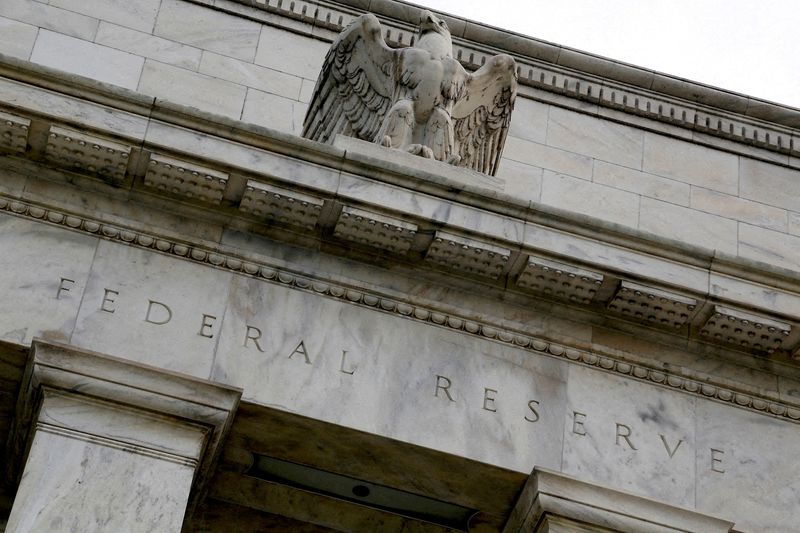 © Reuters. An eagle tops the U.S. Federal Reserve building’s facade in Washington, July 31, 2013. REUTERS/Jonathan Ernst/File Photo
© Reuters. An eagle tops the U.S. Federal Reserve building’s facade in Washington, July 31, 2013. REUTERS/Jonathan Ernst/File Photo
By Howard Schneider
WASHINGTON (Reuters) – As they navigated the onset of the COVID-19 pandemic Federal Reserve officials had a steady progression of descriptions for inflation, first saying it remained too low, then calling its rise transitory and later citing “broader” price pressures.
In September 2021, they settled at last on “elevated.”
That final word is also likely the final hurdle between policymakers and interest rate cuts which likely won’t begin until “elevated” is dropped from the Fed’s policy statement in favor of a new phrase acknowledging inflation was closing in on the central bank’s 2% target.
With inflation now below the level that caused the Fed to call it “elevated” in the first place, a turn in the policy statement could come as soon as the Fed’s March 19-20 meeting and open the door to rate cuts beginning after that.
Assuming inflation continues toward a lower path policymakers could “just change the sentence – ‘inflation has eased closer toward goal,'” said Dreyfus & Mellon Chief Economist Vincent Reinhart, who helped draft central bank policy statements in his former role as head of the Fed’s monetary affairs division.
New policy projections issued at the March meeting would also let the Fed reset expectations about the nine months left in the year, and “once you adjust the forecast you adjust the policy stance,” Reinhart said.
Information that may help guide those projections will come Friday when the U.S. Bureau of Labor Statistics publishes revised inflation figures for 2023 calculated using new seasonal adjustment factors, statistical weights that aim to more accurately reflect how prices behaved over the year.
Last February’s annual revision went in a bad direction for the Fed, showing that inflation fell less than initially estimated after hitting a peak in June 2022. The revisions caused some policymakers to question whether underlying price trends had turned in their favor as much as they thought.
A similar setback is not expected this time, but officials including Fed Governor Christopher Waller say they will be watching.
“My hope is that revisions confirm the progress we have seen. But good policy is based on data and not on hope,” Waller said at a Brookings Institution event last month.
‘FAVORABLE TRAJECTORY’?
The updated Consumer Price Index data will be released Friday at around 8:30 a.m. (1330 GMT), with new inflation data for January following next week. The Fed uses a separate measure to set its 2% target – the Personal Consumption Expenditures price index – but the two have some overlap, so Friday’s revisions have the Fed-watching world on edge.
Usually an unheralded affair as economic data releases go, Friday’s annual revision will be held under a microscope and poses a potential pothole for Fed rate cut plans if it shows inflation was higher over the course of last year than estimated. Most economists, however, expect the revisions this time to affirm last year’s decline in inflation.
Oxford Economics Chief U.S. Economist Ryan Sweet said the data this time could even surprise in a Fed-friendly way, lowering month-to-month inflation estimates for the second half of 2023 and showing slightly faster “disinflation.”
Replicating BLS adjustment methods indicates CPI may have been slightly higher at the start of 2023 but was “lower for midyear and in December. The revision toward the end of the year would leave inflation on a more favorable trajectory heading into this year,” Sweet wrote.
If last year’s data remain close to intact, it means CPI over the last half of 2023 rose at a 3.4% annual rate – dramatically slower than the 8.4% annualized pace during the six months before the Fed first called inflation “elevated” in its policy statement.
Inflation accelerated fast in 2021. At the Fed’s March 2021 meeting, the latest data available from February showed inflation still stalled below the 2% target.
The escalation in following months earned a passively voiced comment in the policy statement that “inflation has risen” reflecting “transitory factors” with no implicit sense that it would keep rising.
The declarative “inflation is elevated” arrived in September 2021, and each statement since has said that remains the case.
A downgrade would complete the Fed’s pivot away from a sole focus on inflation and towards lower interest rates.
“I don’t know that we’ve worked out the particular statement language and that kind of thing,” said Fed Chair Jerome Powell when asked at his press conference following the Fed’s last meeting how policymakers may step away from “elevated”
While Powell said that a measure of underlying inflation followed closely by the Fed remained above target in December, at 2.9%, it is “way down from where it was. Very very positive development. Very fast decline…The case is likely that it will continue to come down.”

